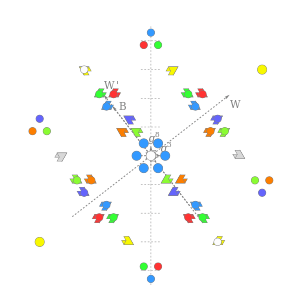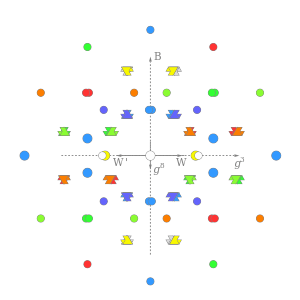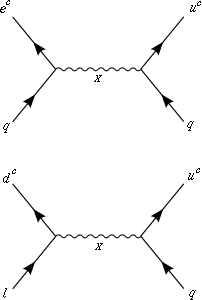SO(10) (physics)


In particle physics, one of the grand unified theories (GUT) is based on the SO(10) Lie group. (The Lie group involved is not really the special orthogonal group SO(10), but rather its double cover Spin(10); but calling it SO(10) is the standard convention.)
Before SU(5), Harald Fritzsch and Peter Minkowski and independently Howard Georgi found that all the matter contents are incorporated into a single representation, spinorial 16 of SO(10). (Historical note: the before in the previous sentence is misleading: Georgi found the SO(10) theory a few hours before finding SU(5) at the end of 1973.[1])
Important subgroups
It has the branching rules to [SU(5)×U(1)χ]/Z5.
If the hypercharge is contained within SU(5), this is the conventional Georgi–Glashow model, with the 16 as the matter fields, the 10 as the electroweak Higgs field and the 24 within the 45 as the GUT Higgs field. The superpotential may then include renormalizable terms of the form Tr(45 ⋅ 45); Tr(45 ⋅ 45 ⋅ 45); 10 ⋅ 45 ⋅ 10, 10 ⋅ 16* ⋅ 16 and 16* ⋅ 16. The first three are responsible to the gauge symmetry breaking at low energies and give the Higgs mass, and the latter two give the matter particles masses and their Yukawa couplings to the Higgs.
There is another possible branching, under which the hypercharge is a linear combination of an SU(5) generator and χ. This is known as flipped SU(5).
Another important subgroup is either [SU(4) × SU(2)L × SU(2)R]/Z2 or Z2 ⋊ [SU(4) × SU(2)L × SU(2)R]/Z2 depending upon whether or not the left-right symmetry is broken, yielding the Pati–Salam model, whose branching rule is
Spontaneous symmetry breaking
The symmetry breaking of SO(10) is usually done with a combination of (( a 45H OR a 54H) AND ((a 16H AND a  ) OR (a 126H AND a
) OR (a 126H AND a  )) ).
)) ).
Let's say we choose a 54H. When this Higgs field acquires a GUT scale VEV, we have a symmetry breaking to Z2 ⋊ [SU(4) × SU(2)L × SU(2)R]/Z2, i.e. the Pati–Salam model with a Z2 left-right symmetry.
If we have a 45H instead, this Higgs field can acquire any VEV in a two dimensional subspace without breaking the standard model. Depending on the direction of this linear combination, we can break the symmetry to SU(5)×U(1), the Georgi–Glashow model with a U(1) (diag(1,1,1,1,1,-1,-1,-1,-1,-1)), flipped SU(5) (diag(1,1,1,-1,-1,-1,-1,-1,1,1)), SU(4)×SU(2)×U(1) (diag(0,0,0,1,1,0,0,0,-1,-1)), the minimal left-right model (diag(1,1,1,0,0,-1,-1,-1,0,0)) or SU(3)×SU(2)×U(1)×U(1) for any other nonzero VEV.
The choice diag(1,1,1,0,0,-1,-1,-1,0,0) is called the Dimopoulos-Wilczek mechanism aka the missing VEV mechanism and it is proportional to B−L.
The choice of a 16H and a  breaks the gauge group down to the Georgi–Glashow SU(5). The same comment applies to the choice of a 126H and a
breaks the gauge group down to the Georgi–Glashow SU(5). The same comment applies to the choice of a 126H and a  .
.
It is the combination of BOTH a 45/54 and a 16/ or 126/
or 126/ which breaks SO(10) down to the Standard Model.
which breaks SO(10) down to the Standard Model.
The electroweak Higgs and the doublet-triplet splitting problem
The electroweak Higgs doublets come from an SO(10) 10H. Unfortunately, this same 10 also contains triplets. The masses of the doublets have to be stabilized at the electroweak scale, which is many orders of magnitude smaller than the GUT scale whereas the triplets have to be really heavy in order to prevent triplet-mediated proton decays. See doublet-triplet splitting problem.
Among the solutions for it is the Dimopoulos-Wilczek mechanism, or the choice of diag(0,0,0,1,1,0,0,0,-1,-1) of <45>. Unfortunately, this is not stable once the 16/ or 126/
or 126/ sector interacts with the 45 sector.[2]
sector interacts with the 45 sector.[2]
Matter
_-_16_Weight_Diagram.svg.png)
The matter representations come in three copies (generations) of the 16 representation. The Yukawa coupling is 10H 16f 16f. This includes a right-handed neutrino. We can either include three copies of singlet representations φ and a Yukawa coupling  (see double seesaw mechanism) or add the Yukawa interaction
(see double seesaw mechanism) or add the Yukawa interaction  or add the nonrenormalizable coupling
or add the nonrenormalizable coupling  . See seesaw mechanism.
. See seesaw mechanism.
Proton decay
- These graphics refer to the X bosons and Higgs bosons.
-

Dimension 6 proton decay mediated by the X boson
 in SU(5) GUT
in SU(5) GUT -

Dimension 6 proton decay mediated by the X boson
 in flipped SU(5) GUT
in flipped SU(5) GUT
Note that SO(10) contains both the Georgi–Glashow SU(5) and flipped SU(5).



